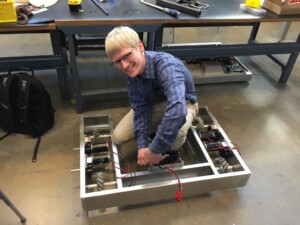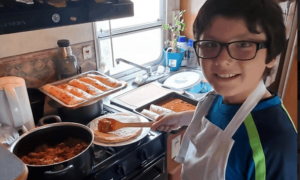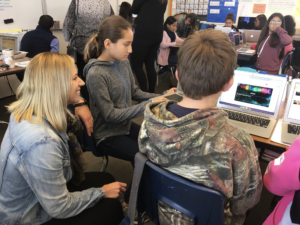Moonshot Project Pays Big Dividends

Massachusetts middle-school students made national news earlier this year when they reached a moonshot goal of $1 million to fund research for a classmate’s rare medical condition. Their business plan involved selling jars of cookie dough mix and using social media to go viral with their campaign. Along the way, they learned about fractions, marketing, media, and empathy, as well as medical research.
It’s a remarkable story, but behind the headlines is another tale worth telling about the benefits of giving teachers time and support to design high quality Project Based Learning (HQPBL) experiences.
A Project Takes Shape
The cookie jar project was the brainchild of sixth-grade math teacher Kathy Simms at Ipswich Middle School. She is part of a cohort of 15 teachers from across the district who volunteered for a year-long PBL initiative.
Last November, Simms and the rest of the cohort took part in a three-day PBL workshop facilitated by the Buck Institute of Education. Rather than starting with a brand-new project idea, Simms decided to remodel a unit about fractions and measurement that she has done in the past.
In previous years, she had students calculate the amount of ingredients needed to assemble jars of holiday cookie mix. The first time she introduced the unit, she just had students make calculations on paper. The next year, they also assembled jars of ingredients. Students seemed more engaged in that hands-on task, but Simms still wasn’t satisfied with the learning outcomes.
 “The math wasn’t as rich as I wanted,” she reflected. “And at the end, each kid just took home a jar of cookie mix. That seemed kind of wasteful. If we did it again, I thought it should be a fundraiser.”
“The math wasn’t as rich as I wanted,” she reflected. “And at the end, each kid just took home a jar of cookie mix. That seemed kind of wasteful. If we did it again, I thought it should be a fundraiser.”
Design Makes the Difference
When Simms designed the new project plan, she paid particular attention to two key criteria for HQPBL.
She increased the intellectual challenge by emphasizing math problem-solving. Inspired by the insights of math educator Robert Kaplinsky, Simms decided to do less scaffolding during the calculations part of the project. Making the challenge more open-ended meant students would have to rely on their own questions and turn to their teammates to talk through potential strategies.
She also ramped up the authenticity of the project by introducing a real-world fundraising goal that she knew her students would embrace. One of the Ipswich Middle School students is an outgoing girl named Talia Duff who suffers from a rare neurological disease known as CMT4J (for Charcot-Marie-Tooth Neuropathy Type 4J). Currently, there is no cure; however, Talia’s parents started a non-profit foundation, CureCMT4J to develop a treatment or cure. CureCMT4J’s researchers have found great success with gene therapy in mouse models. The foundation continues to raise funds to take the science to a human clinical trial for Talia and others. Simms saw the opportunity for her students to use cookie jar sales to contribute to a nonprofit fundraising goal of $1 million, which would support further research involving human trials. The foundation leading the effort was less than halfway to its goal after more than a year of fundraising. “I thought maybe we could contribute a few thousand dollars,” Simms recalls.
 Two weeks after the PBL workshop ended, Simms launched the project with her sixth-grade teaching team. It soon took off in a way she never could have imagined.
Two weeks after the PBL workshop ended, Simms launched the project with her sixth-grade teaching team. It soon took off in a way she never could have imagined.
Going Viral
On a Friday afternoon, Simms sat down after school to debrief with a colleague. By then, students were well along with their calculations. They were having rich math conversations and working effectively in small teams. The project had expanded when the science teacher suggested having students design labels that included not only cooking directions but also information about the nonprofit foundation promoting medical research for CMT4J. Language arts teachers found ways to support the project, as well.
But Simms still wasn’t satisfied. She told her colleague, “If we sell every single jar, we’ll raise $3,600. That’s just a drop in the bucket!” They both teared up, thinking about the immensity of the challenge. But sadness quickly gave way to determination when they agreed, “We need to do something BIG!”
To reach a larger audience, sixth-graders filmed a video about their fundraising effort and began to promote it via social media. High school students joined their crusade, tweeting with the hashtag #RUDuffEnough (in honor of Talia Duff). Others from across the school community used Facebook, Twitter, and Instagram to spread the word.
 “It just took off,” Simms says. Before long, national news crews were setting up to film her classroom (ABC, for example, covered the project on three separate nights).
“It just took off,” Simms says. Before long, national news crews were setting up to film her classroom (ABC, for example, covered the project on three separate nights).
One month after the project launch, the $1 million fundraising goal was achieved.
Lasting Lessons
Tracy Wagner, director of teaching and learning for Ipswich Public Schools, was pleased to see such a compelling project emerge from the district’s year-long PBL initiative. The cohort meets regularly to learn as a community, provide peer feedback, observe each other’s classrooms, and develop a library of PBL units. Administrators are also participating and learning right alongside teachers.
“Kathy and her team identified how an existing unit could be more academically rigorous, and also have more impact on the community. She did a brilliant job of revising the previous unit,” Wagner added, to emphasize criteria for high quality PBL.
 The district has had pockets of successful projects in the past, but the current goal is to bring high quality PBL districtwide. Having teachers like Simms share their insights and reflections with colleagues is one strategy to make PBL sustainable.
The district has had pockets of successful projects in the past, but the current goal is to bring high quality PBL districtwide. Having teachers like Simms share their insights and reflections with colleagues is one strategy to make PBL sustainable.
In hindsight, Simms can see the importance of having time outside of her regular class to develop a detailed project plan. “I was able to take an idea, think quietly, talk to people, use protocols to run through ideas, go home and sleep on it, and come back the next day to make it better. Without that focused time,” she adds, “I don’t think this project would have had such impact.”
This blog is a part of the High Quality Project Based Learning Campaign supported by the Buck Institute for Education and sponsored by the Project Management Institute Educational Foundation and the Hewlett Foundation. For more, visit hqpbl.org and follow @hqpbl #hqpbl on Twitter and Instagram.
For more, see:
- What Makes High Quality PBL?
- High Quality PBL Framework on the Horizon
- The Purposes of High Quality PBL
Suzie Boss is the author of several books about project-based learning and member of the Buck Institute for Education National Faculty. Connect with her on Twitter @suzieboss.
Stay in-the-know with all things EdTech and innovations in learning by signing up to receive our weekly newsletter, Smart Update.





0 Comments
Leave a Comment
Your email address will not be published. All fields are required.